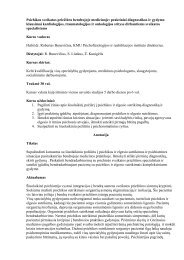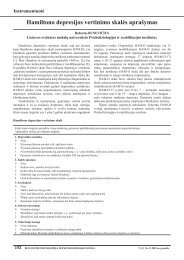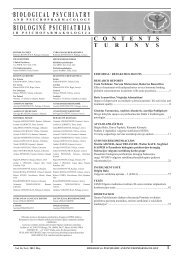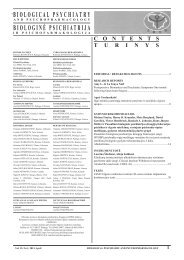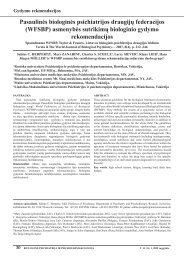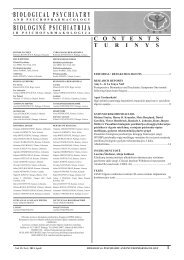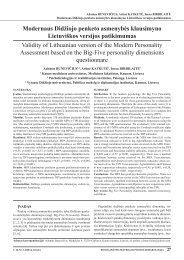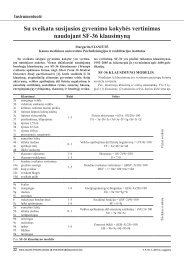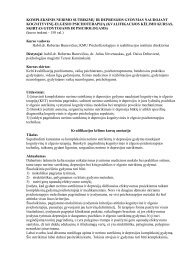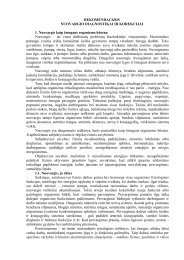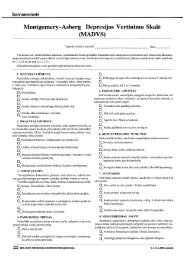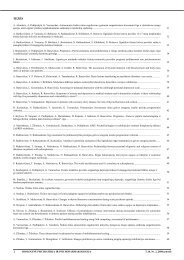Enigma of Bipolar depressionBipolinės depresijos mįslėElmārs RancānsDepartment of Psychiatry, Riga Stradins University, Riga, LatviaElmārs RancānsEnigma of Bipolar depressionSUMMARYBipolar disorder is a prevalent and disabling mental disorder. Annualprevalence rates vary from 1–6% depending on the diagnostic criteriaused in the studies. Substantial part of the bipolar disorder is spent indepressive phase of the illness. The clinical picture of it resemblesthat of Major depressive disorder, what causes difficulties in makingan appropriate diagnosis and selecting effective treatment. Severalstudies found relatively high percentage of diagnose conversionfor patients with diagnosis of depressive episode at index admission12,9–49 %. The higher rate in family history of mental disorders, especiallybipolar disorders, younger age of onset of f<strong>ir</strong>st depression,more atypical symptoms like hypersomnia and weight gain; higherrate of suicidal attempts, recurrence and hospitalisations; more complextemperamental dysregulations could help to recognise bipolardepression.The therapeutic management of bipolar disorder may be extremelycomplex, because of the episodic course, the usually severe disabilityassociated with the acute manic and especially depressive phases ofillness.Conventional mood stabilisers and antidepressants are frequentlyprescribed for the acute and prophylactic management of bipolar depression.This prescription patterns continues despite proofs of the<strong>ir</strong>limited efficacy and risks of inducing mood swings. Several noveltreatments, such as th<strong>ir</strong>d-generation anticonvulsants, atypical antipsychoticsand dopamine agonists have been actively studied for thisindication.Based on the current published evidences lithium, lamotrigine andquetiapine monotherapy, olanzapine plus selective serotonin reuptakeinhibitors (SSRI), and lithium or divalproex plus SSRI/Bupropioncontinue to remain the f<strong>ir</strong>st-line options for the management of bipolardepression.Key words: bipolar depression, anticonvulsants, antidepressants,atypical antipsychotics.SantraukaBipolinis sutrikimas – paplitusi negalią sukelianti psichikos liga. Metinissergamumas svyruoja nuo 1 iki 6 proc. bendros gyventojų populiacijos,– priklausomai nuo to, kokie diagnostiniai kriterijai naudojamityrimų metu. Pagrindinę bipolinio sutrikimo trukmės dalį užimadepresijos fazė. Klinika panaši į didžiosios depresijos, o tai sukeliasunkumų diagnozuojant <strong>ir</strong> parenkant veiksmingą gydymo būdą. Keletastyrimų nustatė santykinai didelį depresija sergančių pacientų diagnoziųpakeitimo procentą, kai priimtinas rodiklis yra 12,9–49 proc.Bipolinę depresiją gali padėti atpažinti tokie veiksniai, kaip psichikosligos šeimos anamnezėje, ypač bipolinis sutrikimas; jaunesnis amžiusp<strong>ir</strong>mąkart sus<strong>ir</strong>gus depresija; daugiau atipinių simptomų, tokių kaiphipersomnija <strong>ir</strong> svorio priaugimas; daugiau suicidinių bandymų, recidyvai<strong>ir</strong> hospitalizacijos; sudėtingesnis temperamentas.Bipolinio sutrikimo gydymas gali būti ypač sudėtingas dėl epizodinėseigos, paprastai gana sunkaus neįgalumo, susijusio su ūmine manija,o ypač dėl šios ligos depresijos fazių.Ūminei būklei gydyti ar bipolinės depresijos prevencijai dažnai yrask<strong>ir</strong>iami įprastiniai nuotaikos stabilizatoriai <strong>ir</strong> antidepresantai. Toksgydymas vis tebesk<strong>ir</strong>iamas, nepaisant įrodymų apie šių vaistų ribotąveiksmingumą <strong>ir</strong> galimai sukeliamus nuotaikų svyravimus. Šiomsindikacijoms gana aktyviai t<strong>ir</strong>iama keletas naujų medikamentų, tokiųkaip trečios kartos vaistai nuo epilepsijos, atipiniai antipsichotikai <strong>ir</strong>dopamino agonistai.Remiantis dabar skelbiamais įrodymais, ličio, lamotrigino <strong>ir</strong> kvetiapinomonoterapija, olanzapino <strong>ir</strong> selektyviųjų serotonino reabsorbcijosinhibitorių (SSRI) derinys <strong>ir</strong> ličio ar divalproekso derinys su SSRI/bupropionuišlieka p<strong>ir</strong>mos eilės vaistais gydant bipolinę depresiją.Raktažodžiai: bipolinė depresija, vaistai nuo epilepsijos, antidepresantai,atipiniai antipsichotikai.IntroductionThe term bipolar disorder describes usually episodic andclinically sometimes extremely severe and dramatic presentation.Bipolar disorder encompasses several phenotypes.Cross-sectionally, bipolar patients may present with eitherdepressive, or manic or hypomanic episodes; additionally awide spectrum of other psychopathological features may bepresent. This considerable cross-sectional phenotypic heterogeneitycontinues to be the source of some controversy andthe exact clinical characteristics of bipolar disorder are subjectto debate. The core diagnostic criterion of bipolar disorderis the presence of a manic syndrome, defined as a periodin which the person suffers from unusually and clinicallysignificant extreme good mood or <strong>ir</strong>ritability and experiencesa number of explicitly defined associated symptoms (i.e. decreasedneed to sleep, hyperactivity and impa<strong>ir</strong>ed control).Although, typically, patients with a manic episode also experiencemajor depressive episodes, bipolar disorder can bediagnosed even if only one manic episode and no past majordepressive episodes are present, in such a cases diagnosis ofBipolar disorder type I is assigned. Another disorder type isBipolar disorder type II, which differ form type I only bypresence of hypomanic but no manic episodes. Hypomanicepisodes differ from mania by a shorter duration (at least 4days instead of 1 week), and less severe impa<strong>ir</strong>ment (not severeenough to cause marked impa<strong>ir</strong>ment in social or occupationalfunctioning, psychiatric hospitalization, or psychoticfeatures).Address for correspondence: Elmārs Rancāns, MD, PhD, Department of Psychiatry, Riga Stradins University, university, tvaika Tvaika str. 2, Riga Lv LV 1005,Latvia, e-mail: email: erancans@latnet.lvT. 10, Nr. 1, 2008 m. b<strong>ir</strong>želisBiologinė <strong>psichiatrija</strong> <strong>ir</strong> psichofarmakologija31
Mokslo darbai, apžvalgaThe epidemiology of bipolar disorder has been addressedin several studies in Europe [1, 2]. The prevalence estimatesfor any bipolar disorders range from less than 1% to over5%. This variation seems to be largely dependent on the typeof study, the diagnostic coverage and the type of assessmentinstrument used. Prospective-longitudinal studies tend to reporthigher rates, possibly because they are more sensitive incatching the lifetime history. The 12-month prevalence of bipolarI disorder is usually estimated to be around 1%, and onaverage similarly high for hypomania (bipolar II, 1,2%). BipolarII prevalence findings show much more variation withestimates up to 6%, especially if cyclothymia – a trait-likevariant – and other bipolar-spectrum like conditions are considered.Some authors suggested to separate additional formsof bipolar disorders like types III and IV [3].Bipolar disorder usually takes a recurrent and severecourse with an increasing number of manic, depressive andmissed episodes of variable severity and duration over thepatient’s lifetime. The majority of patients with bipolar Iwill frequently receive drug treatment over the<strong>ir</strong> lifetime toprevent further episodes. Over 60% of all patients affectedwill requ<strong>ir</strong>e hospitalization during the course of the<strong>ir</strong> disorder.The therapeutic management of bipolar disorder may beextremely complex, because of the episodic course, the usuallysevere disability associated with the acute manic and especiallydepressive phases of illness. The article will reviewefficacy of different treatment options in the management ofdepressive phase of bipolar disorder.Prevalence and clinicalFeatures of bipolar depressionPatients with Bipolar disorders presented one or othertype of affective symptoms almost half of the<strong>ir</strong> lives over 13years of observation. Depressive symptoms accounted from67 to 93 % of time spend in ill state [4, 5]. The depressedphase of Bipolar disorder, albeit usually much less colourfulthan mania, is more likely to lead to psychosocial impa<strong>ir</strong>mentsand shorten lives.Several studies found relatively high percentage of diagnoseconversion for patients with diagnosis of depressive episodeat index admission 12,9–49 % [6–9]. By the 15-year follow-up,27% of the study group had developed one or moredistinct periods of hypomania, while another 19% had at leastone episode of full bipolar I mania in one study [9].French multi-centre study (EPIDEP), repeatedly assessedsoft bipolarity symptoms in the population of 537 patients,found higher rate in family history of mental disorders, especiallybipolar disorders, younger age of onset of f<strong>ir</strong>st depression,more atypical symptoms like hypersomnia and weightgain; higher rate of suicidal attempts, recurrence and hospitalisations;more complex temperamental dysregulations[7].The authors in a recent study, comparing 477 subjectswith a diagnosis of bipolar disorder and 1,074 with major depressivedisorder, found that Bipolar depression was associatedwith family history of bipolar disorder, an earlier age atonset, a greater previous number of depressive episodes andmore common fears. Whereas sadness; insomnia; intellectual(cognitive), somatic (muscular), resp<strong>ir</strong>atory, genitourinarycomplaints; and depressed behaviour were more common inpatients with unipolar depression. A logistic regression modelcorrectly classified 86,9% of the subjects [10].Treatment options for bipolardepressionMood stabilisersMood stabilisers are the cornerstone of the treatment ofbipolar disorders. They were the only f<strong>ir</strong>st-line options formonotherapy for bipolar depression up to very recent times.LithiumEight of nine double-blind trials versus placebo suggestthat lithium is superior to placebo in treating bipolar depression[11]. However, most of these trials are methodologicallyquestionable. Only a meta-analysis of these studies has sufficientpatient numbers to conf<strong>ir</strong>m the efficacy of lithium [12].The strength of the antidepressant effect of lithium monotherapycompared to that of other antidepressants also remainsrather unclear. Five rather small double blind trials have beendocumented (for a review, see [13]). I am not aware of publishedcontrolled trials comparing the antidepressant efficacyof lithium with that of antidepressants of the new generationhead to head. Although lithium is also used as an augmentationstrategy in refractory depression, lithium monotherapyby itself may not be sufficient in patients with moderate tosevere bipolar depression.ValproatePreviously, support for divalproex monotherapy for bipolardepression was available only from uncontrolled trials.A prospective, open-label study in 19 patients with bipolarII disorder, depressed phase, demonstrated an antidepressanteffect of valproate especially in medication naive patients[14]. This strategy has now shown efficacy in two small randimisedplacebo-controlled study (RCT) in Bipolar depression[15, 16]. A large-scale, placebo-controlled maintenancestudy showed that valproate, but not lithium, was significantlybetter than placebo in preventing a depressive relapse [17].However, this was a secondary analysis of a trial that failedon its primary outcome measure.CarbamazepineSimilar to valproate, carbamazepine has been much lessstudied in the treatment of acute bipolar depression than inmania and prophylaxis. The majority of studies again mixedunipolar and bipolar depressed patients. Some trials suggestedmoderate efficacy [18, 19], including one placebo-controlledtrial [20], but others did not replicate this [21]. In thelatter trial, the response rate for carbamazepine did not appearto be better than that expected for placebo. Thus, similarto valproate, carbamazepine is not to be recommended as amonotherapy for bipolar depression, although it may be helpfulto prevent a switch into mania.LamotrigineOf all available so-called mood stabilisers, lamotrigine issupported by the largest trials suggesting acute antidepressantefficacy. Although, it failed to show significance for theprimary outcome variable, namely the Hamilton Depression32 Biologinė <strong>psichiatrija</strong> <strong>ir</strong> psichofarmakologija T. 10, Nr. 1, 2008 m. b<strong>ir</strong>želis
- Page 1 and 2: ISSN 1648-293XB i o l o g i n ė p
- Page 3 and 4: Redakcijos skiltisDepresijos gydyma
- Page 5 and 6: Mokslo darbaiĮVADASDidėjant serga
- Page 9: Mokslo darbaidažnį tarp 35-74 m.
- Page 13 and 14: Mokslo darbaiSergančiųjų koronar
- Page 15 and 16: Mokslo darbaiFizinis krūvis, W90,0
- Page 17 and 18: Mokslo darbaiFizinis nuovargis paci
- Page 19 and 20: Mokslo darbaiPaskutinių metų duom
- Page 21 and 22: Mokslo darbaiLITERATŪRA:1. Rozansk
- Page 23 and 24: Mokslo darbaitarpu dėl hipoksijos
- Page 25: Mokslo darbaiΔRR B, ms ΔRR B, %
- Page 28 and 29: Adomas Bunevičius, Arūnė Katkut
- Page 30 and 31: Adomas Bunevičius, Arūnė Katkut
- Page 34 and 35: Elmārs RancānsEnigma of Bipolar d
- Page 36 and 37: Elmārs RancānsEnigma of Bipolar d
- Page 38 and 39: Virginija Adomaitienė, Darius Lesk
- Page 40 and 41: Virginija Adomaitienė, Darius Lesk
- Page 42 and 43: Virginija Adomaitienė, Darius Lesk
- Page 44 and 45: Rainald Mössner, Olya Mikova, Elen
- Page 46 and 47: Rainald Mössner, Olya Mikova, Elen
- Page 48 and 49: DisertacijosA.Deksnytės daktaro di



